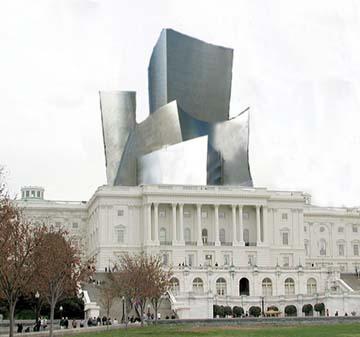If Only They Had Followed Federal Architectural Guidelines!
The Secretary of the Interior’s guidelines for additions to historic buildings say that the additions should be in a modern style, not in the historic style of the original building:
“Recommended: Design for the new work may be contemporary or may reference design motifs from the historic building. In either case, it should always be clearly differentiated from the historic building….”
“Not Recommended: Duplicating the exact form, material, style, and detailing of the historic building in the new addition so that the new work appears to be part of the historic building. Imitating a historic style or period of architecture in new additions…”
Unfortunately, these guidelines were not yet in place when the United States capitol had its two wings and new dome added during the 1850s. The architect was benighted enough to design the additions in the style of the original building. The design obviously has no integrity: you cannot tell where the historic building ends and the additions begin.

If only the additions had been done in our more enlightened times, we could have had a design with more integrity, with the clearly differentiated addition in contemporary style that the Secretary of the Interior recommends.
 And adding some starchitecture to the capitol also could have made it an icon that would attract tourists to Washington, just as starchitecture attracts tourists to Bilbao. A boring classical building could never become a national icon.
And adding some starchitecture to the capitol also could have made it an icon that would attract tourists to Washington, just as starchitecture attracts tourists to Bilbao. A boring classical building could never become a national icon.
(P.S. I know that this picture exaggerates what would be built under the Secretary of the Interior’s guidelines, which also say the addition should “be compatible in terms of mass, materials, relationship of solids to voids, and color.” But it exaggerates to make an obvious point. The guidelines make us design a building that is an incoherent mixture of traditional and modern styles, rather than a coherent building like the national capitol.)
(The Secretary of the Interior’s guidelines for additions to historic buildings are available at http://www.cr.nps.gov/hps/tps/tax/rhb/new01.htm.)
“Recommended: Design for the new work may be contemporary or may reference design motifs from the historic building. In either case, it should always be clearly differentiated from the historic building….”
“Not Recommended: Duplicating the exact form, material, style, and detailing of the historic building in the new addition so that the new work appears to be part of the historic building. Imitating a historic style or period of architecture in new additions…”
Unfortunately, these guidelines were not yet in place when the United States capitol had its two wings and new dome added during the 1850s. The architect was benighted enough to design the additions in the style of the original building. The design obviously has no integrity: you cannot tell where the historic building ends and the additions begin.

If only the additions had been done in our more enlightened times, we could have had a design with more integrity, with the clearly differentiated addition in contemporary style that the Secretary of the Interior recommends.
 And adding some starchitecture to the capitol also could have made it an icon that would attract tourists to Washington, just as starchitecture attracts tourists to Bilbao. A boring classical building could never become a national icon.
And adding some starchitecture to the capitol also could have made it an icon that would attract tourists to Washington, just as starchitecture attracts tourists to Bilbao. A boring classical building could never become a national icon.(P.S. I know that this picture exaggerates what would be built under the Secretary of the Interior’s guidelines, which also say the addition should “be compatible in terms of mass, materials, relationship of solids to voids, and color.” But it exaggerates to make an obvious point. The guidelines make us design a building that is an incoherent mixture of traditional and modern styles, rather than a coherent building like the national capitol.)
(The Secretary of the Interior’s guidelines for additions to historic buildings are available at http://www.cr.nps.gov/hps/tps/tax/rhb/new01.htm.)

1 Comments:
Can't say I agree with your logic.
I wouldn't define the dome as an addition; it is actually a replacement of the previous dome. Which brings to issue the fact that "an exterior addition should be considered only after it has been determined that the new use cannot be successfully met by altering non-character-defining interior spaces."
But given that the required wing extensions did alter the character of the building, a new, bigger dome was required. And when that piece was done, the east portico needed to be rebuilt, as it was now out of proportion and character with the new dome.
So what's going on here? Basically, the building we see now bears little resemblence to the pre-1850 Capitol Building, so in a way it's actually fitting with the Secretary of the Interior's guidelines.
Just goes to show that one can dissect the same text and come up with opposite interpretations.
Personally, I prefer the pre-1850 Capitol. It's less bombastic and expressionistic than the current building, even if a bit crude. While today's Capitol Building is impressive and awe-inspiring (part of the intended effect, I presume), it lacks the subtle charm of its predecessor.
Post a Comment
<< Home